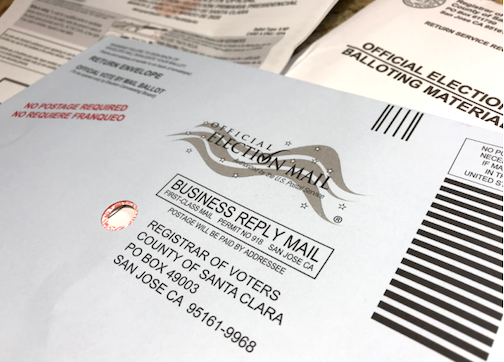
From staff and wire reports
More than 100,000 mail-in ballots were rejected by California election officials during the March presidential primary, according to data obtained by The Associated Press that highlights a glaring gap in the state’s effort to ensure every vote is counted.
In Santa Clara County, officials rejected 6,000 mail-in ballots and in San Mateo County 4,220 in Santa Clara County were rejected.
Of California’s 58 counties, San Mateo had the fifth highest rejection rate at 2.12%.
The main reason San Mateo County rejected so many ballots is that many voters missed the deadline for ballots to be mailed and arrive at the Elections Department. To count in the election, ballots must be postmarked on or before Election Day and received within three days afterward. In San Mateo County, 2,099 ballots missed those deadlines.
Another 2,038 either didn’t have a signature, or the signature didn’t match the one on record for the voter.
In Santa Clara County, officials only rejected 1.41% of ballots, or 6,136.
Again, the main reason was that voters missed the mailing deadlines. In Santa Clara County, 5,531 ballots were rejected for that reason. Another 471 had signature problems.
With the coronavirus pandemic raging, California is part of a growing number of states increasing mail-in balloting to avoid crowds at polling places. President Trump is among those questioning the integrity of vote-by-mail elections while supporters say they are just as reliable as polling places and offer greater flexibility for voters.
But while polling places include workers who can assist people who have questions about filling out ballots, a voter doesn’t have support at home and so problems can arise.
The California secretary of state’s election data obtained by the AP showed 102,428 mail-in ballots were disqualified in the state’s 58 counties, about 1.5% of the nearly 7 million mail-in ballots returned. That percentage is the highest in a primary since 2014, and the overall number is the highest in a statewide election since 2010.
Two years ago, the national average of rejected mail ballots in the general election was about 1.4% and in the 2016 presidential election year it was 1%, according to a U.S. Election Assistance Commission study.
The most common problem, by far, in California was missing the deadline for the ballot to be mailed and arrive. To count in the election, ballots must be postmarked on or before Election Day and received within three days afterward. Statewide, 70,330 ballots missed those marks.
Another 27,525 either didn’t have a signature, or the signature didn’t match the one on record for the voter.
Last March, the highest rejection rate in California was in San Francisco, where 9,407 ballots, or nearly 5% of the total, were set aside, mostly because they did not arrive on time. By contrast, in rural Plumas County northeast of Sacramento, all of the 8,207 mail-in ballots received were accepted.
Some voters apparently filled out their ballots then left them on the kitchen table: In more than 800 instances, envelopes were returned to election officials without the marked ballot inside.
Orange County Registrar of Voters Neal Kelley said ultimately a voter has the responsibility to fill out the ballot correctly and get it in the mail on time. Sometimes, “it’s just a product of voters forgetting,” Kelley said.
Kim Alexander, president of the nonpartisan California Voter Foundation that seeks to improve elections, said the number of uncounted ballots was discouraging.
“The only thing worse than people not voting is people attempting to vote and having their ballot uncounted,” she said. The tally of nullified votes “can make a difference in a close contest.”
Local races sometimes are decided by a handful of votes.
California traditionally has offered mail-in voting only to those who request ballots. Over time the number has grown to represent more than half of all cast ballots. In response to the coronavirus outbreak, Democratic Gov. Gavin Newsom in June signed a law requiring county election officials to mail a ballot to all the state’s nearly 21 million registered voters for the November election.
He called mail-in voting safe and secure, pointing to a series of studies that found no evidence of significant fraud. States across the political spectrum rely solely on mail ballots, including Colorado, Utah and Washington.
In preparation for November, the state is launching a ballot-tracking tool that will quickly alert voters if they need to take action, such as adding a missing signature. Another change: A bill by Assemblyman Marc Berman, D-Menlo Park, has become law that extends the window for mail ballots to arrive to 17 days after Election Day.
Even though he voted by mail this year, Trump has called mail-in voting “a terrible thing” prone to abuse, warning without evidence that “you get thousands and thousands of people sitting in somebody’s living room, signing ballots all over the place.”


